The Microsoft Surface Pro (2017) Review: Evolution
by Brett Howse on June 15, 2017 9:00 AM ESTBattery Life
Previous Surface devices were always fairly efficient, offering a good amount of battery life for the given battery capacity, but the Surface Pro has always been bottlenecked by absolute battery capacity. When you are building a tablet, there’s just not a lot of space for battery when you’ve already packed in an entire PC. The Surface Pro 4 offered 39 Wh of battery capacity, well under the 50 Wh average of most Ultrabooks of its day.
Ultrabooks have continued to add more battery capacity as well, since it’s the single easiest way to improve battery life, and Microsoft has also done that with the new Surface Pro. With new packaging, and smaller components like the BGA SSD inside, they’ve been able to squeeze in a 45 Wh battery in the latest version of the Surface Pro, all without altering the thickness or weight of the system. That, coupled with the more power-efficient Kaby Lake processor, should lead to better overall battery life results. It does have to be noted that the Surface Pro 4 we will be comparing against was the Core i5 model, and despite the same TDP, the Core i5 models tend to do slightly better than Core i7 models of the same device due to the lower maximum boost frequency. But since we didn’t get a chance to test against the Core i7 Surface Pro 4, we’ll make do with what we have.
The new Surface Pro, like other Intel powered Surface devices, does enable Content Adaptive Backlight Control (CABC), or what the Intel calls Display Power Savings Technology (DPST) when on battery, but it's supposed to disable this when plugged in. The CABC doesn't seem very agressive, however it also doesn't appear that it can be disabled as of right now.
One thing we can't comprehensivey test is standby time. The Surface Pro 4, especially shortly after launch, had some power management issues with the Skylake CPU that could cause it to burn through the battery very quickly in Modern Standby. Microsoft has stated that they've seen significant increases in Modern Standby battery life with Kaby Lake. Resume times also seem to be quicker, and more reliable, with the latest CPU.
Battery Life 2013 - Light
Although we’ll be phasing out this older test, it is still the one we have the largest pool of data to compare against, so it’s still interesting to look at even though the test is getting to be much too light even for lower TDP chips.
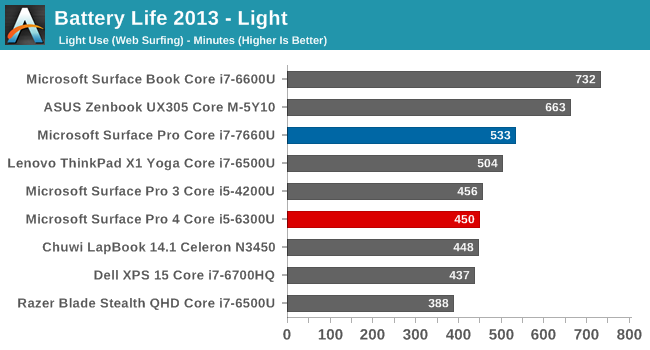
The new Surface Pro does offer longer battery life than the old model, and the gap isn’t insignificant either. This is almost nine hours of uptime at 200 nits, albeit with a very light test. This is with the device set to best battery life, so there’s going to be a boost from that as well.
Battery Life 2016 – Web
Our newer web browsing test is much more demanding, but due to the review schedule, it’s mostly been run on larger gaming laptops only. Consequently there are fewer Ultrabooks to compare it against, but we do have a couple of other machines we’ve tested.
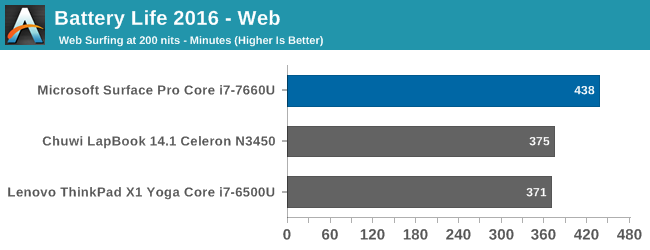
Despite having a smaller battery capacity than the ThinkPad X1 Yoga, which has a 52 Wh battery, the Surface Pro picked up more than an hour of battery life with the display set to 200 nits. This is a strong result, and highlights the efficiency that Microsoft has been able to achieve.
Normalized Web Browsing
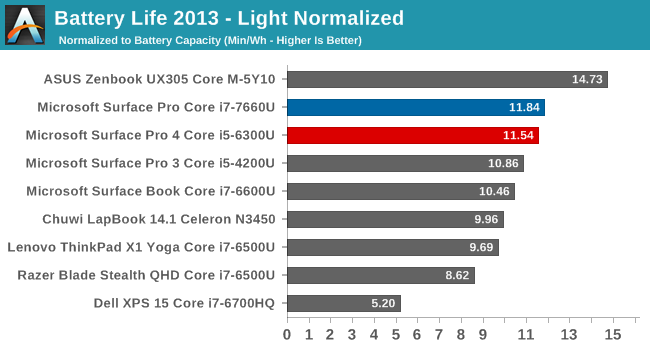
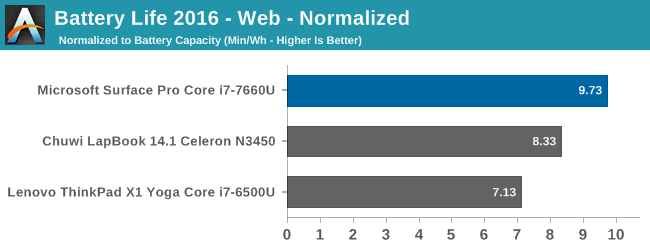
Removing the battery capacity from the results gives a picture of overall device efficiency, and here the Surface Pro really shows what it can do. It’s well ahead of the ThinkPad, which had a Skylake i7, and even ahead of the Atom powered Chuwi LapBook, which utilizes four Goldmont cores.
Looking at the older 2013 test, where there is more data points, the results are very positive. The overall efficiency has ticked up slightly, despite this using a Core i7 CPU and Iris graphics, but the device was set to Best Battery Life, so the maximum power draw would have been trimmed. Surface Pro continues to be one of the most efficient devices we’ve tested. That being said, the majority of the battery life gains are from the increased battery capacity, which is not unsurprising, since the CPU architecture hasn’t changed.
Movie Playback
Microsoft quotes the new Surface Pro at up to 13.5 hours of battery life, and when they quote that value, it’s using local video playback as the source. It would be great to see companies not use video playback as the only source of battery life results, since all of the video functions are offloaded to fixed function hardware on the CPU, allowing the CPU to go into a low power state (and movies, typically darker, also play better with CABC). This exaggerates the results, even though they are technically valid. Most people buying a Surface Pro are likely to be doing more than just watching movies on it, so a more comprehensive test from the Redmond company would likely provide better real world results.
We do run a movie playback as well though, since it’s really a best-case scenario for any device, but we run it with the display set to 200 nits, whereas Microsoft doesn’t quote its screen brightness value.
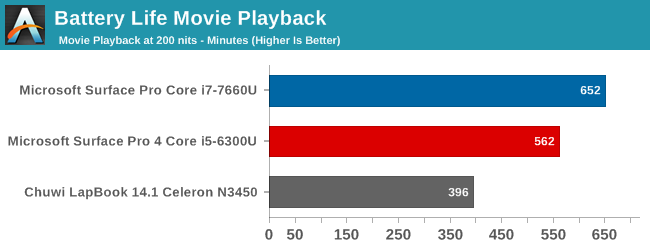
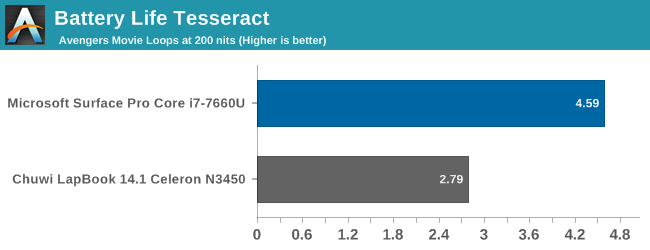
There’s a significant jump in overall battery life on the Surface Pro compared to the previous generation, and we were able to get almost 11 hours of battery life playing back a movie. It’s not quite the 13.5 hours quoted by Microsoft, but it’s close, and we likely run the display brighter. Compared to the Surface Pro 4 though, efficiency doesn’t change very much, and most of the extra life is thanks to the larger battery. That’s not a bad thing of course, since the extra battery capacity is very much welcome.
Charge Time
The new Surface Pro comes with the same 44-Watt adapter, which connects over the magnetic Surface Connect port. The charging adapter also includes a full-size USB port, allowing you to charge other accessories at the same time, without having to take up the single port on the Surface Pro. It is a compact and quiet AC adapter.
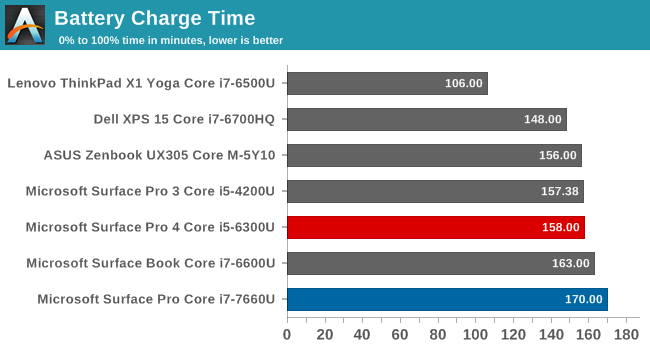
With a slightly larger battery size than the outgoing Surface Pro 4, it’s perhaps no surprise to see that the charging time has increased by a few minutes over the old model. It’s able to hit 50% in just over an hour, and 93% charge in two hours.


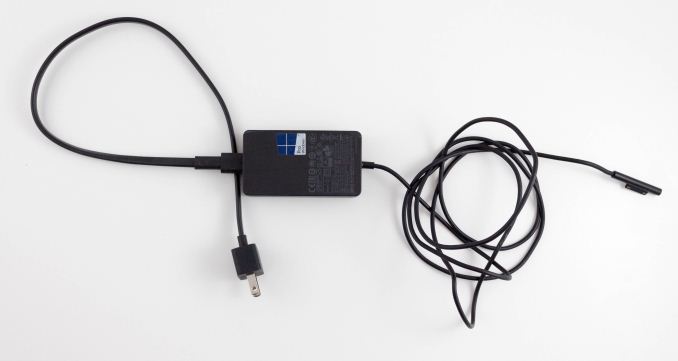
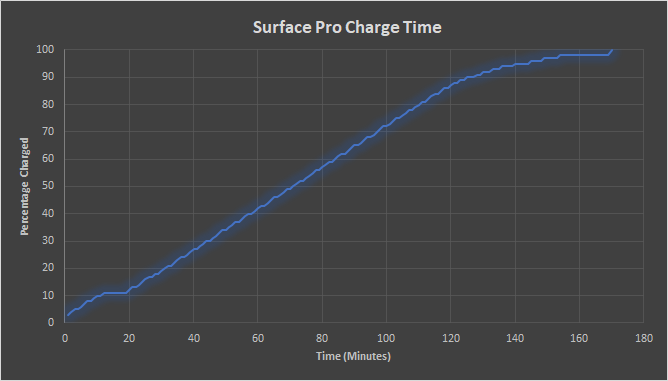








124 Comments
View All Comments
serendip - Thursday, June 15, 2017 - link
Microsoft sells a tiny foldable Bluetooth keyboard with an Alcantara covering. I've been using it for months and it still looks good. It's a lot easier to unfold the keyboard when I need it and I can use the tablet without an attached keyboard in tablet mode. These cover-type keyboards add extra weight and make the tablet hard to use as a tablet.SaolDan - Friday, June 16, 2017 - link
I own a SP4 for personal use and a Huawei matebook for work. Let me tell you that you get used to the keyboard cover and stand theres no going back. i wish my company would give me a sp4 or the new one instead of the matebook. matebook can keep the type c. Type c is very nice but not that necessary for work.simard57 - Wednesday, June 21, 2017 - link
how would you compare the Matebook to the SP4?simard57 - Wednesday, June 21, 2017 - link
my past buying habits were mid level laptops - not top of the line ultrabooks - and the hinge is the Achilles heel of them. plastic and metal hinges are not made for a long marriage. the old adage, you pay for what you get, surely does applytipoo - Thursday, June 15, 2017 - link
Not everyone uses the same coatings on it. Microsoft has shipped alcantara Surface keyboards for years and they hold up well on average. The iPad Pros Apple fabric keyboard, whatever that fabric is, wears more in weeks, Microsofts is still the best fabric tabletey keyboard solution.
BillBear - Thursday, June 15, 2017 - link
If a spray on coating could make the Alcantara covered steering wheels on a Porsche hold up to wear, they would most assuredly already be using it.However, if you check out the video above you'll see that this is simply not the case.
mkozakewich - Saturday, June 17, 2017 - link
If you're talking about that video they posted on Reddit, someone else said the 'wear' is actually just grime that can be washed off.Everyone clings so hard to the marketing material. If the original Type Cover wasn't Alcantara, it was at least something very similar. It had a wonderful feel and withstood the years well. It washed well, too, and looks great even today. I could never stand the weird felt-like stuff they've been using the last few years.
Manch - Saturday, June 17, 2017 - link
My original Surface Pro KB is just fine. The track pad has bit of visible wear but other than that, its still nice. BillBear has been going on and on about the damn Alcantara but you can get a keyboard without it so I don't understand the grief. Anncedotal evidence of Porsche steering wheels, doesnt prove anything. The material is used on all kinds of things with no issues.Brett Howse - Thursday, June 15, 2017 - link
Only time will tell if the polyurethane coating on the Surface Signature Type Cover holds up well, but I've been using the Surface Ergonomic Keyboard on my desk for over six months now, and the Alcantara still looks almost new. YMMV, of course, but the normal Surface Type Cover can get beat up too. I don't see this as the major downside of others. At worst, it's going to be about the same as what we've already got.Manch - Saturday, June 17, 2017 - link
Or you could buy the regular type cover with or without the fingerprint sensor instead of the Alcantara